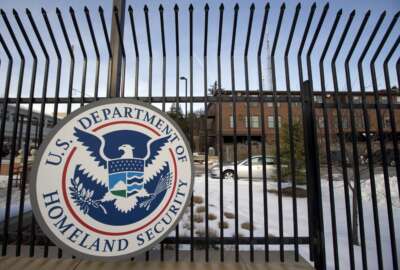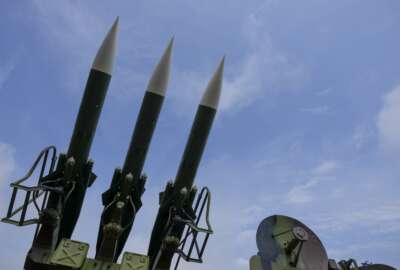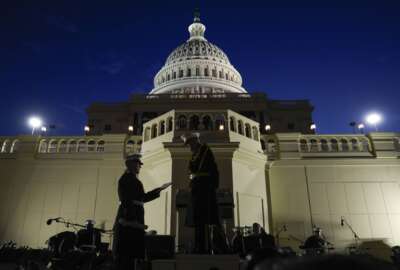Adm. John Harvey, Veterans Affairs Secretary, Virginia Commonwealth
The all volunteer force has made it easier to deploy forces around the world, according to some military policy experts. No one is proposing bringing back the...
The all volunteer force has made it easier to deploy forces around the world, according to some military policy experts. No one is proposing bringing back the draft, but downsizing may create an opportunity to take a new look at how the military is structured. Retired U.S. Adm. John Harvey is Secretary of Veterans and Defense Affairs for the Commonwealth of Virginia. He’s former Commander of U.S. Fleet Forces Command. He shared his Top 3 for 2015 on In Depth with Francis Rose. He said there are two big pieces to consider.
Adm. John Harvey’s Top 3 for 2015
- The future of the all-volunteer force: It has been relatively “easy” for the President to decide to employ and deploy U.S. military forces since 1972 and the inception of the all-volunteer force. Our forces have generally gone where the President directed, when he chose to deploy those forces and congressional authorization for the use of military force has generally followed the president’s decision.
So for the last 13 years, the U.S. military has gone to war, but the nation has not. Volunteers — constituting a very small percentage of the nation’s population — fought the wars in Afghanistan and Iraq. Confronting the true costs of these conflicts was deferred through deficit spending. We did not fully mobilize either our reserve forces or the National Guard to fight these wars. Instead, we chose to repeatedly deploy a smaller force for longer periods of time to meet the manpower demands of the wars.
The OPTEMPO for the American military that became the norm during the past 13 years has not changed all that much even as we have drawn down our presence in Afghanistan and Iraq. The world continues to be a violent and disordered place, and we have chosen to maintain a larger percentage of a smaller force forward-deployed to sustain our global vital interests in the face of a rising China, a resurgent Russia and continued conflict throughout the Middle East.
Not surprisingly, the costs associated with sustaining an all-recruited, all volunteer force under such conditions have increased. These personnel-related costs now absorb a larger share of a shrinking defense budget and have prompted repeated calls from defense leaders to suppress military pay increases, reduce housing cost supplements, reshaped retirement plans and re- examined retiree medical benefits in order to reduce personnel costs and increase procurement, research and development and readiness funding.
On Feb. 1 2015, the Military Compensation and Retirement Modernization Commission, created by the Congress to deal with the concerns driven by rising compensation costs, will report its findings and recommendations to the President and the Congress. This report, which will come too late to impact the President’s proposed 2016 budget, will certainly ignite the debate over the true costs of the all-volunteer force and what this nation is willing to pay to sustain that force into the future.
- The future of nuclear deterrence: In the United States, the material condition and operational effectiveness of the nuclear forces tasked with providing our assured deterrent have continued a steady decline since the end of the Cold War and the dissolution of the Soviet Union. Additionally, the nuclear weapons complex that sustains the nation’s stockpile of nuclear weapons and assures their current and future readiness has also deteriorated.
Plans to replace the current “triad” (bombers, ICBMs and ballistic missile submarines) that comprise our nuclear forces and restore the nuclear weapons complex (warhead maintenance facilities, R&D labs and critical component manufacturing capabilities) will require significantly more funding than is currently programmed in the Future Year Defense Plan and will certainly result in exceeding the budget caps mandated by the 2011 Budget Control Act.
With a declining defense budget, can the current triad be sustained? If not, what will make up our deterrent force? Does the concept of deterrence in the early years of the 21st century mean the same as it did in the middle years of the 20th century?
The answers to these very complex and extremely important questions must come in 2015 if we are to sustain the concept of nuclear deterrence as it is currently embodied in the triad of nuclear forces.
- Ensuring the readiness of today’s forces: How do we answer the key readiness questions in 2015: Ready for what? Readiness of what? Ready by when and for how long? As we deal with the looming reality of sequestration, while simultaneously attempting to sustain a very high operational tempo and respond to a variety of crises around the globe?
In our special radio report, Top 3 for 2015, federal experts tell In Depth host Francis Rose what top three concepts, trends or priorities they believe will be important in 2015.
Copyright © 2025 Federal News Network. All rights reserved. This website is not intended for users located within the European Economic Area.





